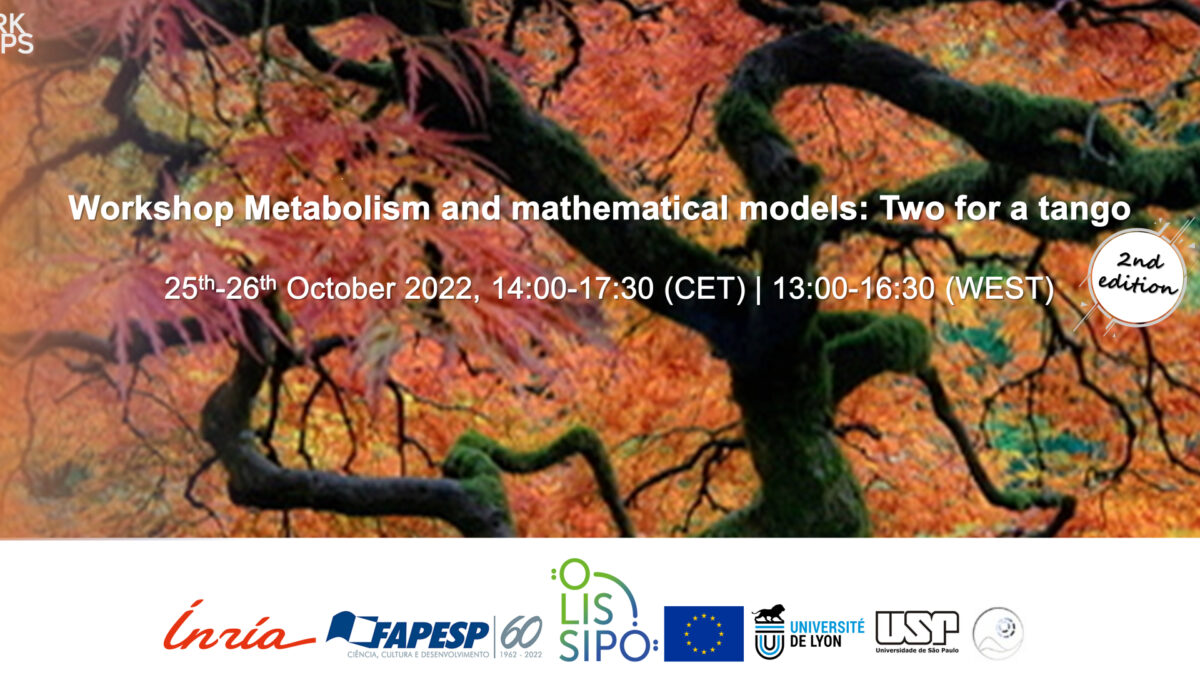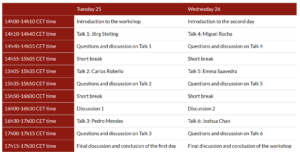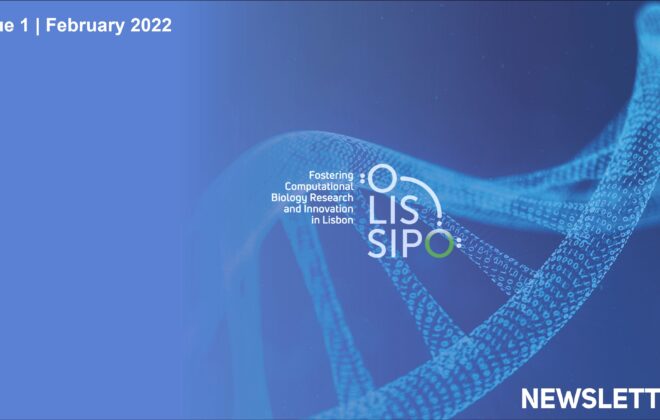
Workshop Metabolism and mathematical models: Two for a tango | 2nd Edition
The topic of this workshop was metabolism in general, with a special focus, although not exclusive, on parasitology. Besides an exploration of the biological, biochemical and biomedical aspects, the workshop also aime at presenting some of the mathematical modelling, algorithmic theory and software development that have become crucial to explore such aspects.
The workshop was open to all members of these two projects but also, importantly, to the community in general.
Agenda:

Keynote lecturers:
Joshua Chan (Colorado State University, US)
Title talk: Modeling stable metabolic interactions in microbial communities
Short abstract: Metabolic modeling has been increasingly applied to predicting and understanding the metabolism of microbial communities. However, there are critical challenges in generating accurate predictions. One challenge is that the widely used flux balance analysis was developed initially for modeling single organisms and omits important ecological and evolutionary principles for multi-organism communities. We discussed our progress in applying some of the relevant concepts such as population steady state and Nash equilibrium for improving predictions and going beyond the assumptions in flux balance analysis.
Pedro Mendes (University of Connecticut Health Center, US)
Title talk: Metabolic model development with COPASI
Short abstract: COPASI is a generic biochemical pathway modeling and simulation software. Its most basic features are to simulate the dynamics of biochemical models using differential equations or stochastic simulation. However the software contains many other algorithms that are useful for developing models, including their calibration through parameter estimation, and further analyses. I briefly described these features with illustrations applied to metabolic models.
Carlos Robello (Institut Pasteur de Montevideo and Faculty of Medicine, Uruguay)
Title talk: From gene profiling to inferences about metabolic changes in Trypanosoma cruzi infection
Miguel Rocha (University of Minho, Portugal)
Title talk: Constraint-based modeling of human metabolism and artificial intelligence towards biomedical applications
Short abstract: Constraint-based modeling (CBM) allows to model cell’s metabolism at a genome-scale, considering some assumptions over the cellular systems (e.g. pseudo-steady state). While these assumptions are not valid in all cases, these approaches allowed to address relevant research and industrial questions, mainly within bioengineering. Some relevant results have been obtained, for example, in metabolic engineering, where combining flux balance analysis, and its variants, for phenotype prediction, with mathematical optimization methods, has allowed to develop rational strain design methods that greatly enhanced industrial endeavours. The application of these approaches to biomedical problems has also been a prolific via for many research groups. In these cases, generic models of human metabolism have been reconstructed, combined with a plethora of available omics data, to reach methods that can predict the behaviour of metabolic systems, both in regular (healthy) conditions, and its deregulation in diseases. Although a large portfolio of publications and other scientific outcomes have been achieved in this direction, the road is still much ahead. In this talk, some of these efforts of constraint-based modeling for biomedical applications were reviewed, focusing on the effort to address cancer metabolism, one of the major application areas, but also other biomedical applications. We reviewed recent advances in the field, but also current limitations and future prospects. We also discussed how Artificial Intelligence can be a relevant partner in this effort and how the community has been addressing its synergies with CBM to empower drug target discovery using metabolic models.
Emma Saavedra (Instituto Nacional de Cardiologia Ignacio Chavez, Mexico)
Title talk: Kinetic modeling and Metabolic Control Analysis to understand the control and regulation of metabolic pathways
Short abstract: Kinetic Modeling of metabolic pathways is a bottom-up Systems Biology approach that builds computational models using detailed kinetic properties of the pathway enzymes/transporters and thermodynamic constraints of the reactions. A key aspect for accurate kinetic model predictions is that the enzyme parameters be determined under near-physiological experimental conditions, especially pH, temperature and medium composition. Metabolic Control Analysis (MCA) is a biochemical framework that allows elucidating the control structure of metabolic pathways (flux and metabolite concentration control coefficients) of each pathway component. We used COPASI software for kinetic modeling and MCA of the antioxidant defense and glucose metabolism in the human parasites Trypanosoma cruzi and Entamoeba histolytica as well as energy metabolism of cancer cells. After obtaining by modeling the control structure of these pathways, the enzymes/transporters with the highest flux control coefficients were identified, validated experimentally and proposed as targets with the highest therapeutic potential. Furthermore, along the iterative process of modelling and experimentation to generate models with highest predictive capacities, novel regulatory mechanisms and feedback loops amongst the pathway components were identified, which revealed some hidden intricacies of regulation in metabolic pathways.
Jörg Stelling (ETH Zürich, Switzerland)
Title talk: Model-based analysis of microbial communities
Short abstract: Microbial community analyses with genome-scale metabolic networks (GSMs) are relevant for many application areas, such as the analysis of the human microbiome. Many of such simulations rely on assumptions about the culturing environment, affecting if the culture may reach a metabolically stationary state with constant microbial concentrations. They also require assumptions on decision-making by the microbes: metabolic strategies can be in the interest of individual community members or of the whole community. Here, we present two approaches to address these aspects of community modeling, either by exploring the whole space of possible community interactions, or by making environment and decision making explicit. First, in the realm of metabolic pathway analysis, we define the minimal pathways (MPs) of a metabolic (sub)network as a subset of its elementary flux vectors. We enumerate or sample them efficiently by iterative minimization and a simple graph representation of MPs. Enumerating all minimal exchanges in a host-microbe model of the human gut predicts exchanges of metabolites associated with host-microbiota homeostasis and human health. Second, we investigate four combinations of assumptions on environment representation and decision-making, and provide novel mathematical formulations for community simulation. Our results stress that different assumption combinations give qualitatively different predictions on microbial coexistence by differential substrate utilization. Both approaches suggest that fundamental mechanisms of community interactions are under-explored in current GSM-based analysis with its strong focus on coexistence states due to division of labor.
Discussions on open questions
For this second edition of the workshop, besides the keynote talks, there were also two slots, one per day, for a discussion on two specific open questions. Each one was managed and moderated by two invited researchers.
For this edition, the open questions and invited researchers were:
- Discussion 1:
- Question: How is it formally established what represents the biomass for a given organism?
- Moderators: Michael Barrett, University of Glasgow, Scotland, and Sanu Shameer, Department of Biology, University of Oxford, UK
- Discussion 2:
- Question: How to accurately establish what is transported in and out of a cell or organism?
- Moderators: Nathalie Poupin, MeX team, INRAE Toulouse, France, and Pierre Millard, INRAE Toulouse, France
Registration
Registration was free.
___
This workshop was being organised by the Inria European Team Erable in the context of OLISSIPO and another project which involves a partnership with the University of São Paulo (USP), in São Paulo, Brazil, more specifically the Institute of Mathematics and Statistics (IME) and the Institute of Biomedical Sciences – Inria Associated Team Capoeira.



